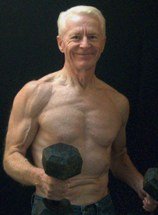Hi

August 15, 2019
In this newsletter . . .
How many steps
did you take today?
Wife, Patty, bought one of those fitness tracker watches. A friend was wearing one and Patty liked it. Don’t ask me the brand name. But it measures blood pressure, heart rate, number of steps taken in a day, and a whole bunch of other things, even sleep patterns. I wouldn’t be surprised if it starts the morning coffee. Patty is high-tech. I still straddle the 20th and 21st centuries.What is curious is her purchase occurred at about the time I was reading where 40 push-ups indicated heart fitness (see my last newsletter), and now she’s wearing a watch that measures steps-per-day as a fitness indicator.
How indicative, really, of heart health and fitness are these measurements? Honestly, I don’t know. Certainly being able to do 40 push-ups in a row demonstrates a degree of fitness. Those who can do them should be pleased. Still, the credence given the 40 push-ups test as an indicator of actual heart health is, to me, at least a bit questionable.
Another recent measurement (supposedly scientific) claims some longevity predictability can be based on your ability to rise from the floor to standing, without assistance, while sitting with legs crossed. Certainly strong legs and a degree of flexibility are required. (Note: women, generally, may be at a somewhat anatomical disadvantage doing this, though it is not mentioned in what I read). But is it at all a predictor of life span?
Back to the other measurement tool, fitness tracker watches. It has become common belief that one’s goal should be taking 10,000 steps per day. Okay. But where did the figure of 10,000 come from? Is there good science to back it up? Maybe. But the 10,000 number was recently questioned and
now revised downward to 7,500 steps. You can look up the steps question here.
I hope any longevity measurement skepticism on my part doesn’t lead you to think I’m discounting the value of push-ups or taking a lot of steps-per-day. I love push-ups (though at my age I do resistance band chest presses instead) and walking, hiking, backpacking, swimming, biking. Steps. Movement. All of it is good. But maybe I’m just a little suspicious of the numbers passed
around as predictors of longevity.
In any event, if striving for exact numbers helps people achieve fitness, I’m all for it. Patty loves techie devices and it fits her personality. I, on the other hand, tend to trust how a number of repetitions feel, when deciding how much to do. When I was younger, I was a meticulous keeper of training journals, with precise records of sets, reps, pounds lifted and distances traveled. But not so much anymore.
In my beginners’ program for seniors, I recommend starting out with a five minute walk, and adding five minutes on each subsequent outing, until regular 30-minute walks are achieved. How many steps are taken during the walks? It’s individually determined, depending on each person’s pace and distance traveled. For those who want to know their numbers, a steps tracker might be just the ticket.
Sincerely,
Logan
Senior Exercise Central
If you like the newsletter, we're making it easy to share it . . .





Newsletter Policy
The Gray Iron Fitness Newsletter is a free publication sent twice monthly to subscribers. The purpose is to provide honest and realistic fitness information for people age 50 and above.
I have never been paid or received compensation of any kind to write a positive review or endorse a product. If I say that I personally use a product or service, it is because I find value in it and have paid for it with my own money.
Like newspapers, magazines and television, this newsletter and my web site contain advertising and marketing links. Naturally, I am compensated for these.
The newsletter and web site provide information to help users establish and maintain a fitness lifestyle. But fitness information is not the same as fitness advice, which is the application of exercise and dietary practices to an individual's specific circumstances. Therefore, always consult with your physician for assurance that fitness information, and
your interpretation of it, is appropriate for you.Your comments and questions are always appreciated. Simply click on the "Reply" bottom.
Sincerely,
Logan Franklin
The Gray Iron Fitness Newsletter
www.senior-exercise-central.com



